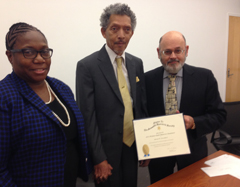February 08, 2016
 George Carruthers received Sigma Xi’s Walston Chubb Award for Innovation on December 9, 2015, at the University of Maryland. The award, which honors and promotes creativity among scientists and engineers, comes with a $4,000 honorarium. Carruthers joined Sigma Xi in 1969. He is a recipient of the National Medal of Technology and Innovation.
George Carruthers received Sigma Xi’s Walston Chubb Award for Innovation on December 9, 2015, at the University of Maryland. The award, which honors and promotes creativity among scientists and engineers, comes with a $4,000 honorarium. Carruthers joined Sigma Xi in 1969. He is a recipient of the National Medal of Technology and Innovation.
Paul Hackett, a student at the university, read the following statement about Carruthers at the Walston Chubb Award ceremony.
In order to move toward future innovations, scientists and engineers with vision promote their ideas as challenges. We call them pioneers. These include Dr. Robert Goddard and engineer Milton Rosen.
Milton Rosen challenged the scientific community to raise future aerodynamicists in the early 1950s. He thus opened a way to embolden our achievements and inspire what we think about today. One of those great people is Dr. George Carruthers, who took the challenge and became both an astrophysicist and an aeronautical engineer.
Dr. Carruthers grew up during the space race and was intrigued with space science. From a young age, he began building telescopes and model rockets and read avidly in local libraries. His love for space science extended through his youth and eventually led him to pursue degrees in aeronautical, nuclear, and astronomical engineering from the University of Illinois. Following his graduate studies, he accepted a position at the Naval Research Laboratory in Washington, D.C., after receiving a fellowship in rocket astronomy from the National Science Foundation.
Throughout his tenure at the Naval Research Laboratory, Dr. Carruthers has focused his attention on far ultraviolet astronomy. In 1969, he received a patent for his pioneering instrumentation, “Image Converter for Detecting Electromagnetic Radiation Especially in Short Wave Lengths.”
In 1972, Dr. Carruthers’ far ultraviolet camera spectrograph was sent to the moon with the Apollo 16 mission. This device allowed us to take readings of, and understand, objects and elements in space that are unrecognizable to the naked eye and gave us views of stars and the solar systems thousands of miles away. His camera still sits on the surface of the moon. A second version of this camera was sent on the 1974 Skylab space flight to study comets and was used to observe Halley’s Comet, among others.
Throughout his storied career, Dr. Carruthers has never lost focus of the importance of science and engineering and has used his experience and excitement to drive these disciplines to our youth. He has worked with several local community organizations and promoted apprenticeships, and taught at Howard University.
Photo: George Carruthers, center, and his wife, Debra, shown on left, received his Walston Chubb Award for Innovation from Sigma Xi's president-elect, Tee Guidotii, at the University of Maryland.